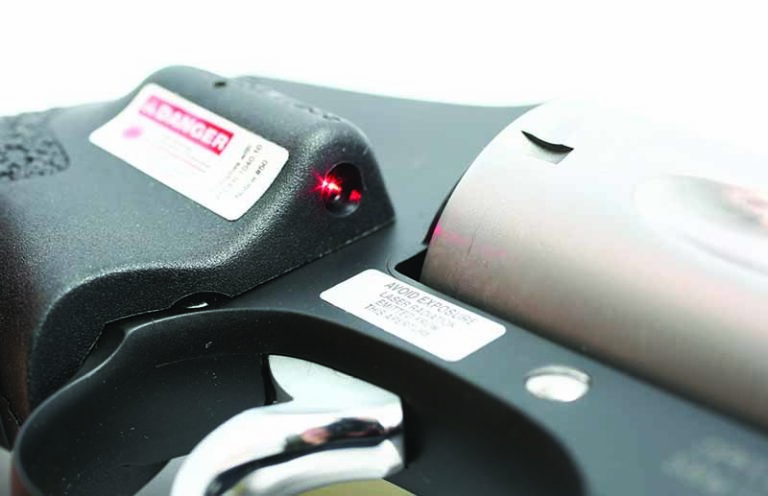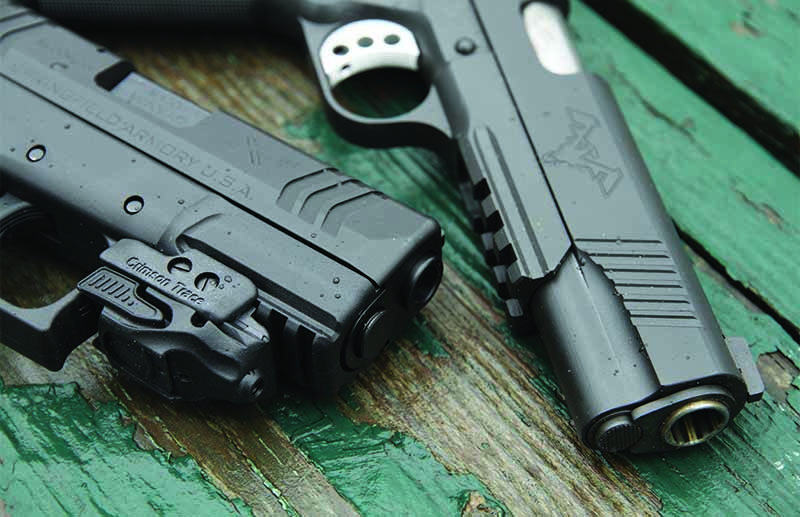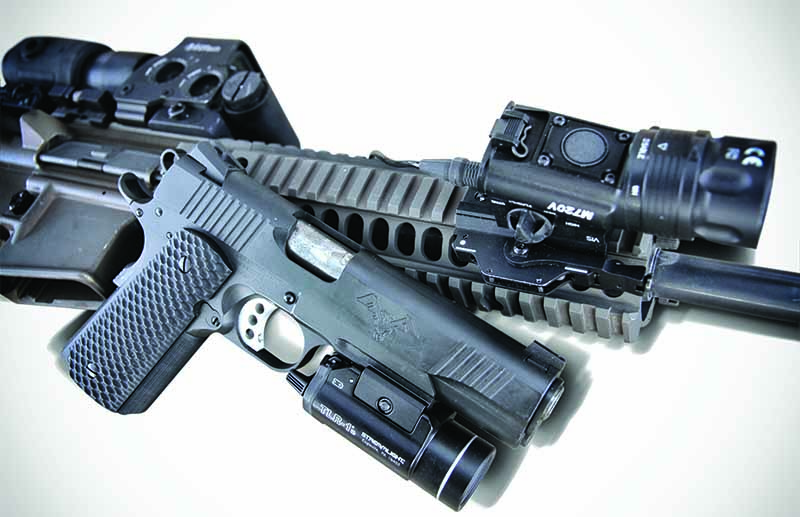
Learn when, where and how to utilize a weapon-mounted laser sight to gain the maximum tactical advantage.
The movie scene is so common that we all let it pass without notice: The entry team goes through the door and into a dark space with multiple laser beams slashing across the interior. The team is here, and they mean business. Sound familiar?

Well, there’s actually a lot wrong with that. First of all, the cinematographer has a real headache when the director wants it. Lasers don’t show up in clean air. Without something in the air, the laser being projected doesn’t “appear” until it strikes the object being aimed at, be it bad guy, wall or target. So, in order for the laser to appear for the camera, the space has to be flooded with smoke, dust or such a high humidity level that it isn’t so much breathing air as swallowing wet air.
But what about real life?
That’s a problem, both in lasers not appearing and lasers “appearing.”
The thing to remember, which applies to both lasers and illumination, is that you leave it off until you need it—and you only have it on as long as you need it. Otherwise, you’re letting the whole world know “Here I am.”
Again, let’s consider our movie entry team. They proceed down the hallway, with laser dots dancing on the walls. At the end, someone is lurking in a room, and he or she counts the dots on the wall. How many? Three? Four? Five? They know the exact count of the team and can gauge distance, so when they pop out, they have a distinct advantage. You, doing a quiet sweep of your house because you heard a noise, are doing the same thing if you leave your laser on.
So, don’t.
Learn the switch location and options on your laser. When you need it isn’t the time you want to be consulting the owner’s manual. It sounds simple, but using a laser isn’t as simple as just turning it on and pointing.

It’s also extremely important that you know the law in your jurisdiction. I’ve been reading on a regular basis the discussions and court opinions on how police use lights and lasers. A bit of historical background: It has been customary for police officers in the past to arrest people by pointing firearms at them. That the person in question might not have done anything at the moment to justify the use of deadly force didn’t matter.
Not so with those of us non-sworn. (Not “civilian,” but that’s a subject for another time.) For those not wearing a badge, pointing a firearm at someone is (and pretty much has always been) assault with a deadly weapon.
That you have a light or laser attached to it and you’re using it for illumination or intimidation doesn’t matter. You’re pointing a firearm at someone. You have to know the legal restrictions on such use and the allowed exceptions. Otherwise, you’ll find yourself in hot water, having assaulted someone. “But a laser is intimidation, and how can I use it without pointing a firearm at someone?” You can’t, as long as it’s attached to the firearm. So, know the law.
Tactful Use Of Weapon-Mounted Lasers
When do you use a laser? Simply put: When the sights aren’t easy to use or impossible to see.

For example, when you’re shooting from awkward positions. Let’s say, just as an example, you’ve fallen or been knocked down in the middle of the street. It’s dark, and the streetlights may not provide enough light to see your sights. (I know, this seems a bit far-fetched, but you never know when it might happen.) As the buddies of the guy who knocked you down are rushing in, flipping the laser on gives you the point of impact indication you need to then decide if you’re in fear of your life and to shoot or not to shoot.
Or, let’s say you’re in a struggle where your attacker has tried to take your firearm. You won’t be able to see the sights, and in the jumble of arms, hands, body checks and bad breath, you might shoot yourself. (Also, a problem when on the ground, and the bad guys are rushing in.)
This is something that happens in force-on-force, and the paint pellets from sims cartridges hurt when you shoot yourself.
In the struggle or on the ground, if you see a laser on the other guy and not on you, then you know you won’t be inadvertently shooting yourself—which is always a good thing.
Mindful Laser Mounting
And that leads me to the next detail: mounting. Install a laser on your defensive weapon close to the bore line, as close as you can manage. A friend of mine has spent some time and effort trying to design and fabricate a mounting system to put the laser directly onto the barrel of his AR-15.

His thought is simple and obvious: You can’t get much closer than right on the barrel. Alas, heat and vibration create insurmountable problems with the idea. However, you should keep in mind that you want the line of your laser beam to be as close to the bore line as possible. You do this for two reasons.
The first is simple: offset. Just as the high-position AR-15 sights make long-range easier, they make close-quarter hits more difficult. You have to remember, inside of 25 yards, the trajectory and line-of-sight through the sights can differ by as much as 2½ inches.
The whole point of a laser is that it’s most useful under the most stressful of situations, situations where you might not remember, oh, that’s right, my laser is 3 inches to the left of my bullet trajectory. That offset is particularly important in the struggle over a firearm, or the hand-to-hand where a laser is useful. Forgetting the offset and shooting yourself isn’t the way to win fights.
The second is that the more off-axis a laser is, the more likely the mount is exposed, sticking out from the firearm, and prone to getting bumped, whacked and banged out of alignment. A laser bumped out of alignment is not only not useful, but it can also be hazardous, as in being in the path of your own bullet we just discussed.

So, on pistols with accessory rails, I like to have the laser back as far from the muzzle as possible, so it’s protected from impact and powder residue. On both pistols and revolvers, I’m particularly fond of the Crimson Trace lasers that are built into the grips. The laser beam is as close as a revolver can get, and closer on pistols than many of the rail-mounted lasers. Their Lasersaddle mounts for shotguns are particularly good in this regard.
Oh, and on shotguns: Don’t believe the “flying cloud of shot” theory of pattern. I’ve shot too many bowling pins (at 25 feet) and seen others miss, to believe that shotgun spread is useful. You can miss with a shotgun—and miss wildly. You use a shotgun for the power, not the “carpet the zip code” pattern spread. The laser tells you where the power will be. Use it.
Adding a laser to your defensive handgun is not a difficult task, neither is learning to effectively use said laser once it’s affixed to your defensive weapon. But when it comes to lasers, it’s always important to sweat the details. A laser will make you more skilled with a defensive weapon … but only after you learn how to properly use it.
The article originally appeared in the November 2020 issue of Gun Digest the Magazine.
Take Aim At Aiming Solutions:
- Red Dot, Green Dot Or Iron Sights?
- Instinctive Advantage Of The Laser Sight
- Secrets To Mounting A Precision Scope On A Long-Range Rifle
- How To: The Basics Of Riflescopes

Next Step: Get your FREE Printable Target Pack
Enhance your shooting precision with our 62 MOA Targets, perfect for rifles and handguns. Crafted in collaboration with Storm Tactical for accuracy and versatility.
Subscribe to the Gun Digest email newsletter and get your downloadable target pack sent straight to your inbox. Stay updated with the latest firearms info in the industry.

![Best Concealed Carry Guns In 2025 [Field Tested] Wilson Combat EDC X9S 1](https://gundigest.com/wp-content/uploads/Wilson-Combat-EDC-X9S-1-324x160.jpg)


![Best 9mm Carbine: Affordable PCCs [Tested] Ruger Carbine Shooting](https://gundigest.com/wp-content/uploads/Ruger-Carbine-Shooting-100x70.jpg)
![Best AR-15: Top Options Available Today [Field Tested] Harrington and Richardson PSA XM177E2 feature](https://gundigest.com/wp-content/uploads/Harrington-and-Richardson-PSA-XM177E2-feature-100x70.jpg)
